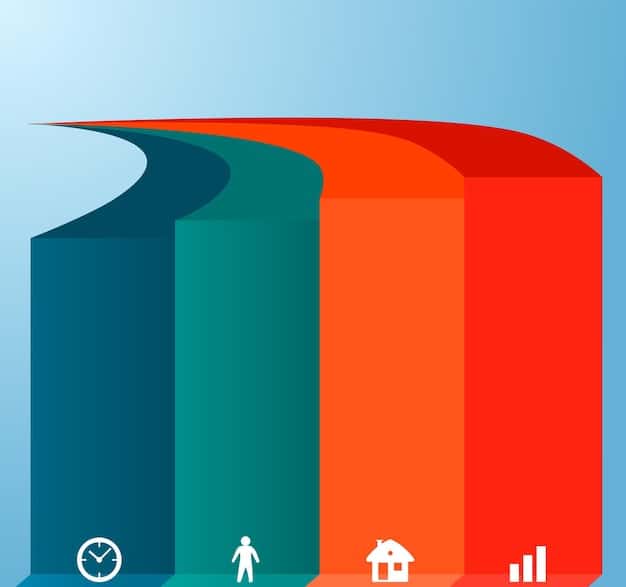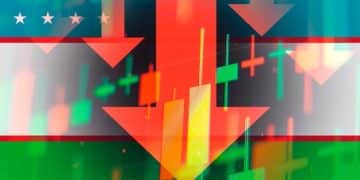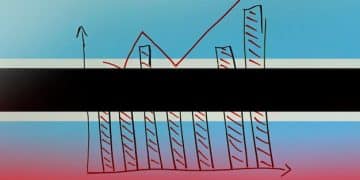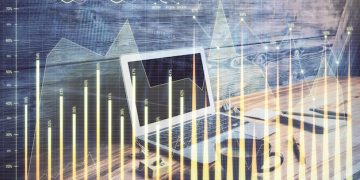Consumer Price Index Jumps 3.5%: Inflation Concerns Rise in New Report

Anúncios
The Consumer Price Index (CPI) increased by 3.5% in the latest report, signaling persistent inflation and raising concerns about the Federal Reserve’s monetary policy decisions.
The latest Consumer Price Index (CPI) report reveals a 3.5% increase, a figure that has economists and consumers alike paying close attention. The rise in the CPI indicates that inflation isn’t cooling down as quickly as hoped, potentially impacting everything from grocery bills to investment strategies.
Anúncios
Understanding the Consumer Price Index (CPI)
The Consumer Price Index, or CPI, is a crucial economic indicator that measures the average change over time in the prices paid by urban consumers for a basket of consumer goods and services. It’s essentially a report card on inflation, showing how much the cost of living is changing.
Understanding the CPI is essential for several reasons. It helps individuals make informed financial decisions, allows businesses to adjust pricing strategies, and guides policymakers in setting monetary policy.
Anúncios
How the CPI is Calculated
The CPI is calculated by tracking the prices of a fixed set of goods and services, known as the “market basket.” This basket includes everything from food and energy to housing and transportation.
The Bureau of Labor Statistics (BLS) collects data from tens of thousands of retail stores, service establishments, rental units, and doctors’ offices across the country to determine the prices of these items.
Different Types of CPI
There are several types of CPI, including the CPI-U (for all urban consumers) and the CPI-W (for urban wage earners and clerical workers). The CPI-U is the most widely used measure of inflation.
- CPI-U: Represents the spending patterns of approximately 93% of the U.S. population.
- CPI-W: Focuses on the spending habits of urban wage earners and clerical workers.
- Core CPI: Excludes volatile food and energy prices to provide a clearer picture of underlying inflation trends.
In conclusion, the CPI is a vital tool for understanding inflation and its impact on the economy. By tracking changes in the prices of goods and services, the CPI helps individuals, businesses, and policymakers make informed decisions.
The Latest CPI Report: A Closer Look
The latest CPI report, revealing a 3.5% increase, has triggered widespread discussion and analysis. This figure is significant because it surpasses previous expectations and indicates that inflationary pressures are more persistent than initially anticipated.
Let’s delve into the key components of the report and understand what’s driving this recent surge in prices.

Key Drivers of the 3.5% Increase
Several factors contributed to the 3.5% increase in the CPI. Energy prices played a significant role, with gasoline and fuel oil experiencing notable spikes.
Food prices also saw an uptick, driven by increases in the cost of groceries and dining out. Housing costs, including rent and homeowners’ equivalent rent, continued to rise steadily.
Impact on Different Sectors
The CPI increase has varying impacts across different sectors of the economy. Consumers are feeling the pinch at the gas pump and grocery store, while businesses are grappling with rising input costs.
- Energy Sector: Higher energy prices can lead to increased production costs for businesses and reduced consumer spending on other goods and services.
- Food Industry: Rising food prices can impact restaurant profitability and household budgets, potentially leading to changes in consumer behavior.
- Housing Market: Continued increases in housing costs can exacerbate affordability challenges for renters and homebuyers.
In summary, the latest CPI report paints a complex picture of the current economic landscape, with rising prices affecting various sectors and consumer spending patterns.
What the 3.5% CPI Rise Means for Consumers
The 3.5% rise in the CPI directly impacts consumers in numerous ways, influencing their purchasing power, savings, and overall financial well-being. Understanding these impacts is crucial for navigating the current economic climate.
Let’s explore the specific ways this CPI increase is affecting consumers’ daily lives.
Erosion of Purchasing Power
As prices rise, consumers’ purchasing power diminishes. This means that the same amount of money buys fewer goods and services than it did before.
For example, if the price of a gallon of milk increases by 10%, consumers need to spend 10% more to purchase the same amount of milk.
Impact on Savings and Investments
Inflation can also erode the value of savings and investments. If the rate of inflation is higher than the return on savings accounts or investments, the real value of those assets decreases.
- Savings Accounts: Low interest rates on savings accounts may not keep pace with inflation, leading to a decline in real savings value.
- Fixed-Income Investments: Bonds and other fixed-income investments can lose value if inflation rises unexpectedly.
- Stocks: Stocks may offer some protection against inflation, as companies can potentially raise prices to maintain profitability.
In conclusion, the CPI increase has significant implications for consumers, affecting their purchasing power, savings, and investment strategies. It’s important for individuals to adapt their financial plans to account for these inflationary pressures.
The Federal Reserve’s Response to Rising Inflation
The Federal Reserve (Fed) plays a critical role in managing inflation and maintaining price stability. The recent 3.5% CPI increase has put pressure on the Fed to take action to curb rising prices.
Let’s examine the Fed’s tools for combating inflation and discuss the potential policy responses to the latest CPI report.
Tools for Combating Inflation
The Fed has several tools at its disposal to manage inflation. The most commonly used tool is adjusting the federal funds rate, which is the target rate that banks charge each other for overnight lending.
By raising the federal funds rate, the Fed can make borrowing more expensive, which can help to slow down economic growth and reduce inflationary pressures.
Potential Policy Responses
In response to the 3.5% CPI increase, the Fed may consider several policy options. One option is to continue raising interest rates to cool down the economy.

Another option is to reduce the Fed’s balance sheet by selling off some of the assets it accumulated during the pandemic. This would further tighten monetary policy and help to reduce inflation.
- Interest Rate Hikes: Raising interest rates can help to slow down economic growth and reduce inflationary pressures.
- Balance Sheet Reduction: Selling off assets can further tighten monetary policy and help to reduce inflation.
- Forward Guidance Communicating the Feds intentions
In summary, the Federal Reserve is closely monitoring the latest CPI report and is prepared to take action to address rising inflation. The Fed’s policy responses will have significant implications for the economy and financial markets.
Expert Opinions and Economic Forecasts
The 3.5% CPI increase has prompted a range of reactions from economists and financial analysts. Expert opinions on the implications of the report vary, with some predicting further inflationary pressures and others anticipating a more moderate outlook.
Let’s explore some of the expert perspectives and economic forecasts surrounding the latest CPI data.
Differing Perspectives on Inflation
Some economists believe that the 3.5% CPI increase is a sign that inflation is becoming entrenched in the economy. They argue that persistent supply chain disruptions, labor shortages, and strong consumer demand are contributing to ongoing price pressures.
Other economists contend that the recent CPI increase is a temporary phenomenon and that inflation will eventually subside as supply chain issues are resolved and demand moderates.
Economic Forecasts and Predictions
Economic forecasts for the coming months vary depending on the assumptions made about inflation, economic growth, and monetary policy. Some analysts predict that the Fed will need to aggressively raise interest rates to combat inflation, which could lead to a slowdown in economic growth.
Other analysts believe that the Fed can gradually tighten monetary policy without causing a recession. They anticipate that inflation will eventually moderate on its own as supply and demand come into better balance.
In conclusion, the economic outlook remains uncertain, with differing perspectives and forecasts surrounding the latest CPI data. Monitoring expert opinions and economic indicators will be crucial for navigating the evolving economic landscape.
Strategies for Businesses to Navigate Inflation
Businesses are facing significant challenges in navigating the current inflationary environment. Rising input costs, supply chain disruptions, and changing consumer behavior are all impacting profitability and growth.
Let’s examine some strategies that businesses can use to mitigate the effects of inflation and maintain a competitive edge.
Pricing Strategies
Businesses may need to adjust their pricing strategies to account for rising input costs. However, raising prices too much could alienate customers and lead to a decline in sales.
One approach is to implement value-based pricing, which focuses on the perceived value of the product or service rather than simply marking up costs. Another strategy is to offer tiered pricing options to cater to different customer segments.
Cost Management Measures
Businesses can also take steps to manage costs and improve efficiency. This may involve renegotiating contracts with suppliers, streamlining operations, and investing in technology to automate tasks.
- Renegotiate Supplier Contracts: Seeking better terms with suppliers can help to reduce input costs.
- Streamline Operations: Improving efficiency can lower operating expenses and boost profitability.
- Invest in Technology: Automating tasks can reduce labor costs and improve productivity.
In summary, businesses need to be proactive in navigating the inflationary environment. By implementing effective pricing strategies, managing costs, and focusing on customer retention, businesses can weather the storm and emerge stronger.
| Key Point | Brief Description |
|---|---|
| 📊 CPI Increase | The CPI rose by 3.5%, indicating persistent inflationary pressures. |
| 💰 Consumer Impact | Erosion of purchasing power and changes in savings/investment strategies. |
| 🏦 Fed Response | Potential interest rate hikes and balance sheet adjustments. |
| 🏢 Business Strategies | Adjust pricing and manage costs to navigate inflationary pressures. |
Frequently Asked Questions (FAQ)
▼
The CPI measures the average change over time in the prices paid by urban consumers for a basket of consumer goods and services. It’s a key indicator of inflation.
▼
It helps in making informed financial decisions, allows businesses to adjust pricing strategies, and guides policymakers in setting monetary policy.
▼
Energy prices, food prices, and housing costs all contributed to the 3.5% CPI increase in the latest report.
▼
It erodes purchasing power, impacts savings and investments, and influences overall financial well-being as prices rise.
▼
Businesses can adjust pricing strategies, manage costs, renegotiate supplier contracts, and streamline operations to mitigate the effects of inflation.
Conclusion
The 3.5% rise in Consumer Price Index highlights the ongoing challenges of inflation in the US economy. Consumers and businesses alike must remain vigilant and proactive in adapting their financial strategies to navigate this evolving landscape. Monitoring economic indicators and seeking expert advice can help in making informed decisions and mitigating the potential impacts of rising prices.





